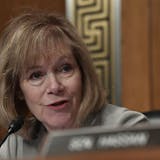The Upper Harbor Terminal in Minneapolis probably is polluted, it's bisected by rail and high-voltage lines that make parcels less attractive, and it will be expensive to redevelop, but the city now has a road map for doing so.
The 48-acre industrial site between the Lowry Avenue and Camden bridges represents the most ambitious bridgehead in the city's 15-year-old dream of reshaping its upper riverfront.
The terminal is a city port that's being phased out this year in favor of redevelopment plans that call for a business park with a strip of green along the river, containing a parkway and trails. A just-released plan for converting that ambition to reality over the next 30 years from consultants working for the city's development agency now goes to City Council members for briefings.
It doesn't recommend a specific split of business and park uses for the site but outlines several scenarios as examples that give an idea of a timetable and the cost.
"They're test fits, just scenarios. Probably the reality will not be like any of them," said Ann Calvert, a city development official.
But the examples give the most concrete sense yet of the site's possibilities and the costs of making it attractive to developers. The scenarios estimate public costs for roads, parks and other infrastructure investments that range from $14 million to $22 million, not counting off-site street improvements. Calvert said the agency has a budget to continue more specific studies in 2015 to further determine the site's needs.
Cost is one obstacle. The area was used for truck farming until the port was built in 1968, but its role for trans-shipping commodities, including grain, coal, gravel, fertilizers and metals, leaves city officials assuming it will need at least modest soil cleanup. Studies of that haven't begun.
Another obstacle is that it's generally a long, skinny piece of land. The site is split by a CP Rail line running north-south and by a parallel high-voltage line closer to the river that serves Xcel Energy's Riverside power plant. The plan calls it feasible to move the power line next to the rail line to create bigger parcels that might be more attractive to developers. It estimated a cost for that of about $2 million. Xcel said it had no immediate comment because it lacks sufficient details.


